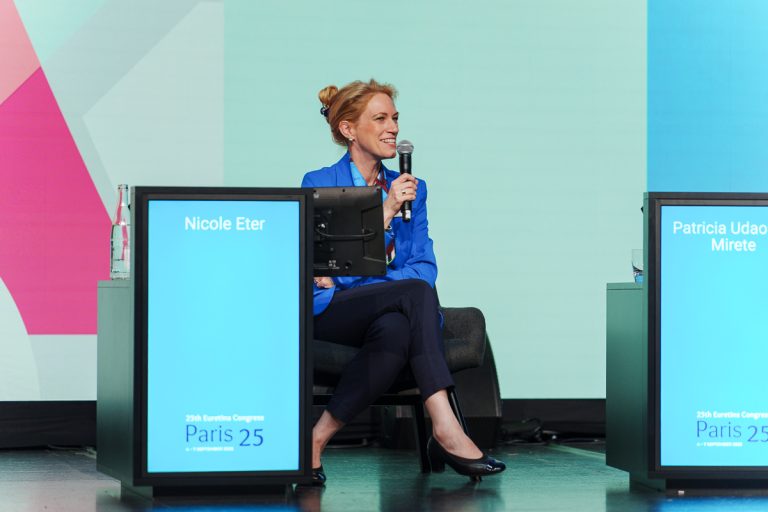Cleverly titled “Eye Openers”, this session was a new addition to the meeting programme in 2025 that featured leading vitreoretinal surgeons presenting videos of their management of challenging, high stakes cases. Case discussions and questions to the presenters by the other speakers and session chairs, Dr. Nicole Eter (Germany) and Dr. Patricia Udaondo Mirete (Spain), provided additional learnings about do’s and don’t for surgery in these situations.
In the first talk of the session, Dr. Kourous Rezaei (United States) showed a video of a patient who developed a suprachoroidal haemorrhage after undergoing retinal detachment (RD) surgery elsewhere. was undergoing vitrectomy for retinal detachment. The patient was on oral warfarin and had a high INR (10).
Dr. Rezaei’s video demonstrated an elegant technique of draining the suprachoroidal blood through the pars plana using valved trocars. Most of the blood was successfully drained, and the retina stayed attached. Unfortunately, the patient’s final vision was poor, which Dr. Rezaei attributed to optic nerve damage secondary to the high intraocular pressure. “Management of intraocular pressure while waiting for the blood to liquify and be drained is a remaining challenge with suprachoroidal haemorrhage,” he said.
Dr. Şengül Özdek (Turkey) presented a case showing the management of advanced bullous RD in the right eye of a baby with Coats disease. The child was born prematurely at 32 weeks gestational age and had undergone laser treatment elsewhere at 38 weeks postmentrual age (PMA) for what was misdiagnosed as asymmetric retinopathy of prematurity. Dr. Özdek saw the patient on referral at 42 weeks PMA for the bullous RD.
Surgery for the RD was complicated by the development of a huge iridodialysis during external drainage of subretinal fluid that Dr. Özdek addressed with a “sewing machine” technique. In addition to making surgeons aware of the potential for iridodialysis to occur in such cases and the use of a sewing machine technique for repair, she emphasised the need to ablate all the dilated telangiectatic vessels in Coats disease in addition to avascular retina, even if the diagnosis of Coats disease is not certain.
Dr. Roxane Hillier (United Kingdom) presented the surgical management of a case involving bilateral simultaneous tractional RD in a patient with both poorly controlled diabetes mellitus and sickle cell anaemia. She observed that there are particular surgical challenges in such cases where there is profound retinal ischaemia caused by a ‘double hit’ of vascular pathologies. Tee including aggressive pre-retinal fibrosis and friable retinal tissue. Dr. Hillier’s video showed how with surgery, the retina was successfully reattached and prevented sight loss in both eyes.

Stanislao Rizzo (Italy) presented a case of a one-eyed, 54-year-old myopic patient who had undergone vitrectomy four months earlier for RD from a giant tear in the lower segments with tamponade with Densiron, a heavy silicone oil. The patient presented with count fingers BCVA and the retina was unexplorable due to opacity of the Densiron bubble.
Dr. George Caputo (France) presented a case of a single-eyed patient who developed an RD in 2005 that was treated elsewhere with placement of a hydrogel scleral buckle. In 2010 the patient developed ophthalmoplegia that was treated by his surgeon in 2011 with partial ablation of the buckle. The patient presented to Dr. Caputo in 2022 with total ophthalmoplegia along with buckle extrusion and infection.
Dr. Caputo’s plan was to fully remove the buckle, but he anticipated encountering scleral perforation or thinning and difficulty relating to buckle fragmentation over time with calcified pieces adhering to the sclera. Reflecting on how the earlier management led to a desperate situation, Dr Caputo’s message was, “You must not leave the dust under the carpet.”









